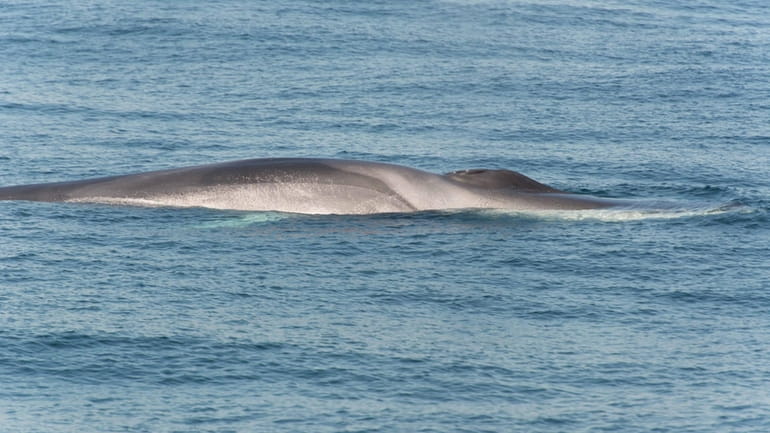Fin whales taking up year-round residency in Long Island waters, study says

A new acoustic buoy recently deployed by scientists from the Woods Hole Oceanographic Institution and the Wildlife Conservation Society detected the songs of the fin whales year-round off Long Island and New York City. Credit: Ph.D.for CRESLI
The waters off the Long Island coast have a new, and very large, occupant.
A report published Thursday in Scientific Reports by the Bronx-based Wildlife Conservation Society and the Woods Hole Oceanographic Institution in Massachusetts found that the New York Bight, which stretches from Montauk to Cape May, New Jersey, has become the year-round home for endangered fin whales — the second largest animal on the planet behind blue whales.
Researchers placed recording devices on acoustic buoys roughly 20 miles off shore that collected thousands of hours of whale songs. They analyzed recordings from 653 days between 2017 and 2020 for the presence of fin whale songs and detected them every month of the year. The songs were most prevalent September through December and somewhat less frequent in the spring to summer, the report said.
The aquatic symphony played by fin whales — which are endangered because of commercial whaling and, more recently, vessel strikes — can generally not be heard by human ears, experts said.
“While they may not be seen as close to shore as other whales and dolphins, it is truly remarkable that the second largest animal to have ever lived on this earth is here in the New York Bight year-round off our coasts,” said Howard Rosenbaum, director of the Wildlife Conservation Society’s Ocean Giants Program and co-author of the study. “Hopefully, our efforts will lead to more efforts and best practices to better protect these amazing, endangered animals in the NY Bight.”
Fin whales — mammoth creatures stretching up to 85 feet long and weighing 40 to 80 tons — were, until recently, considered rare sights in the waters off New York in the summer months.
But experts say environmental conservation efforts have helped restore the region’s coastal wildlife, luring fin whales to the area to dine on krill, squid, and small schooling fish such as herring and menhaden, as well as for breeding activities.
“The New York Bight used to be an area where we had whales sited on a regular basis. We had whaling that occurred here,” said Robert A. DiGiovanni, Jr., founder and chief scientist at the Atlantic Marine Conservation Society in Hampton Bays. “… You have protection measures being put in place for marine mammals. You have food being seen here more readily. And you’re starting to have an ecosystem that could sustain these animals a lot more and maybe for longer periods of time.”
At the turn of the century, there was an uptick in fin whales being struck by vessels in the waters off Long Island, DiGiovanni said.
The new research, the report concludes, can be utilized to develop region-specific management strategies, such as seasonal vessel speed restrictions, to better protect fin whales.
“More information is needed about the distribution and behavior of fin whales within the New York Bight to help inform how this endangered species can be protected from the range of potential stressors and threats encountered year-round in these waters,” said Mindi Rekdahl, a study co-author and associate marine conservation scientist with the Ocean Giants Program at the Wildlife Conservation Society.

